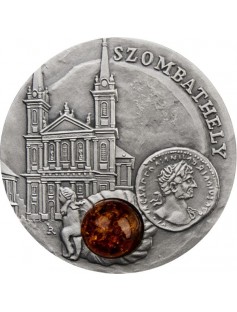- Mintage Limit ONLY - 12000
- Embellished with a amber
- Coin in capsule+with Certificate of Authenticity + Presentation Case
The sixth coin of the ”Amber Route” series is ”Szombathely”. The “Amber Route” is a very popular series of beautiful collector coins struck by the Mint of Poland for the issuer, Niue Island. The characteristic feature of this series is an amber insert and a small mintage. The coins pay tribute to the main cities which lay along this ancient route of commercial contacts. The route connected the European states at the Mediterranean Sea and the lands on the southern shore of the Baltic Sea, and was named after the major object of travelers’ desire, amber.
The first trips to acquire this old object of trade exchange were organized as early as in the 5th century. The exact route was never explicitly established, however, it is assumed that it went through Kaliningrad, Gdańsk, Wrocław, Elbląg, Stare Hradisko, Szombathely, Carnuntum and Aquileia.
Obverse:
In the centre, a stylized image of a cart, in which ambers were carried by the Romans from Baltic Sea to Italy. Behind the cart, on the left, a stylized image of a head of the Roman. On the background, a stylized image of a map with Baltic Sea outline. At the top, along the edge, a semicircular inscription: AMBER ROUTE. At the bottom, a semicircular inscription: NIUE ISLAND; above it, a nominal value: 1 Dollar. An image of the Queen Elizabeth II with the Mint’s mark (m/w), on the left of the cart. On the right of the Queen’s head, an inscription: ELIZABETH II; under it, a year of issue.
Reverse:
On the left side – an image of the 18th century Szombathely cathedral. Below of it - a Roman ring featuring Eros with amber insert, next to it - an image of a Roman coin dating back to the times of the existence of the Amber Route. At the top, along the rim – semicircular inscription - SZOMBATHELY.
Szombathely (Hungary) is known also by its Roman name Savaria, or Colonia Claudia Savariensum. The city was founded during the times of Emperor Claudius in 45 AD as a veteran colony of Legio XV Apollinaris. It was an important junction where multiple major and local routes crossed, including the Amber Route. During the late Roman times the city was made by the Emperor Constantine the capital of the province Pannonia Superior. Remains of typical Roman structures have been preserved over the years, including the baths, the amphitheater, and the mithraeum, discovered in 2008.


